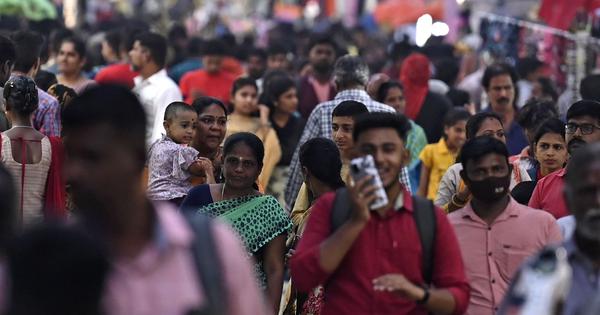
What makes the growth and structural transformation history of India particularly interesting is the fact of a major turnaround in economic growth that also allowed some of the stymied structural transformations to be turned around, even if partially and differentially. These changes defy easy explanations, especially for the underperformance of the planning era. For example, the Bardhan rendition that three sets of vested interests – bureaucrats, politicians and industry – thwarted reform and growth in the planning era runs into the problem that these same interests were unable to block what turned out to be dramatic changes in India’s fortunes – for the better – beginning in 1980.
There is little dispute that India’s growth turned around in the early 1980s. Economic growth soared from about 3.5 per cent to close to 6 per cent in the 1980s. The differences relate to characterising that dramatic improvement.
The Left embraced the rising growth because it was due to a rise in government spending, especially in public investment, and an increase in domestic savings. The Right dismissed the growth as unsustainable and blamed the very factors praised by the Left, namely, Keynesianism on steroids. In this view, the crisis of 1991 is evidence of the unsustainability of that policy, especially since the turbocharged Keynesian was financed by large increases in external borrowings (India’s external debt increased from 11 to 31 per cent of GDP between 1980–81 and 1991–92).
Our view, building on the work of Dani Rodrik and Arvind Subramanian, is different. Rodrik and Subramanian dubbed the reform of the 1980s, limited in the first half but accelerated in the second, as pro-business but not pro-market. This becomes immediately evident in light of the understanding of the planning era as one of scarcity caused by throttling the domestic private sector.
In this view, the reforms of the 1980s – which involved the gradual liberalisation of licensing and providing easier access to inputs, foreign exchange and technology, but without real exposure to foreign competition – were a partial undoing of the tax on the domestic private sector. Their main effect was to increase domestic production, as pure import substitution originally intended. In other words, the 1980s reforms amounted to the first true era of import substitution, namely allowing the domestic private sector to benefit from the lack of foreign competition without being onerously encumbered by the Licence Raj.
Two pieces of evidence suggest that import substitution was the strategy of the 1980s. First, manufacturing growth picked up dramatically from about 5 per cent in the planning era to about 7.5–8 per cent in the 1980s. Second, at the same time, India’s export competitiveness did not improve as its global export market share remained broadly unchanged. Even India’s trade-to-GDP ratio, which had declined steadily from the 1950s until the mid-1970s, did not increase significantly in the 1980s. Import substitution is reflected in the fact that domestic production increased without an increase in exports.
A more detailed analysis suggests that in the 1980s, there were three forces at play: the government went on a spending binge that served to increase demand, some of which leaked into imports, increasing the current-account deficit and contributing to the later BoP crisis; there was some modest trade liberalization as more items were shifted to a list of decontrolled imports; and, perhaps most importantly, there was a pro-business shift that reduced the tax on the domestic private sector. The former two should have raised trade but the latter would have mitigated that impact, which explains why overall trade stagnated.
If the 1950–1980 era was defined by a low growth rate, the 1980s led to a rapid increase in growth but without trade playing a significant role. This was, of course, in sharp contrast to the next two decades, which saw rapid growth with an impressive acceleration in trade. Three decades later than they sought and thought, and for a much briefer duration than the early planners wanted, import substitution was truly in place in the 1980s. But it was quickly replaced when the Indian economy was hit by one of its worst financial crises a decade later.
The Left’s claim that increases in government spending, especially public investment, played an important role, sits awkwardly with the data. A growth decomposition shows that the contribution of investment (or capital) was no different in the 1980s as compared to the planning era. The large difference was total factor productivity, which improved by almost 3 percentage points a year. The expansion of demand was accompanied by large increases in productivity growth and in private corporate investment, especially in manufacturing, which would not have been possible without the supply-side reform of eliminating the tax on domestic producers. That public spending could not have been the cause is also suggested by the cross-country evidence. Latin America in the 1970s witnessed large demand expansion but that resulted in high inflation, low growth, no productivity surge and, eventually, financial crises.
As to the Right’s critique that the demand expansion was unsustainable, the response from Rodrik and Subramanian is:
… we do not consider India’s 1991 balance of payments crisis to constitute compelling evidence that the growth of the 1980s was unsustainable. Countries can make macro policy mistakes both when they are stagnating and when they are growing rapidly. Once more, comparative evidence is useful: How many analysts seriously believe that the Asian financial crisis of 1997/98, arguably much bigger in magnitude than India’s in 1991, proves that the rapid growth of the Republic of Korea, Thailand, Malaysia, and Indonesia in the decades prior was unsustainable? And we have seen few analysts arguing that the crises in Latin America (Mexico in 1994, Argentina in 2000, or Brazil in 1998/99) call for a change in the market-based reforms preceding the crises on the grounds that they were unsustainable!
Thus, the 1980s was really a period of import substitution because the elimination of the tax on the domestic private sector raised productivity growth, but trade did not make a large contribution to this, which warrants the characterisation of this period as pro-business, not pro-competition.
One aspect of the growth in the 1980s that is insufficiently recognised is the reversal (by design) of one of the key deficiencies of the planning era, namely its impact on consumption and poverty, which we dub the thwarted Gandhi–Rawls transformation. There was a sharp rise in consumption growth in the 1980s, which, in per capita terms, meant it more than doubled from 1.1 per cent per year in the planning era to 2.5 per cent per year in the import substitution era. It is for that reason, combined with the fact that agriculture posted higher rates of growth, that poverty fell dramatically in the 1980s.
It is also underrecognised that the reversal of depressed consumption in the planning era was achieved through the banking system that Indira Gandhi nationalised in 1969. Loans through the priority sector lending scheme rose substantially, which financed consumption. The forced financing of government operations via the statutory lending requirements imposed on banks allowed for much higher levels of government consumption expenditure.
The period of reforms-led growth (1990–2012) needs some new understanding, both in itself and to gauge the long-run consequences of the first thirty years. What was the development strategy or pattern?
The Left emphasised the rise in inequality and the corruption that ensued, especially in the 2000s when its locus shifted from the allocation of licences under the scarcity era to the allocation of valuable assets whose value stemmed from the interaction between their being fixed in supply at a time of rapid growth, the so-called “rents raj”, involving terrestrial rents (land), subterranean rents (iron ore and coal), ethereal rents (telecommunications spectrum) and financial rents (credit). Major corruption scandals erupted in all these sectors in the 2000s.
In the Right’s rendition, a great deal of emphasis is placed on the repudiation of the distorted incentives of the previous dirigiste strategy. It is true that the reforms in the immediate aftermath of the crisis did, in fact, involve reducing trade barriers, opening to foreign capital, competition and technology and dismantling the Licence Raj.
There is merit in both interpretations. But they are also incomplete. What was distinctive about the growth surge was that it was based on East Asian levels of export and import growth without East Asian-type industrial policies, and it led to East Asian levels of overall growth without producing East Asian structural transformation and employment growth.
The outcomes of the neoliberal phase were driven not just by trade but also by investment. Expressed differently from the supply side, the contribution of both total factor productivity and capital soared. It is the only policy era of the four that saw double-engine growth, propelled both by productivity and capital accumulation. Not only did investment rise sharply but more of it was private. For example, before the neoliberal era, private investment accounted for about a quarter of total investment, which increased to nearly half during that era. Even the public component was directed increasingly towards infrastructure and emphasised building rural roads and connecting the major metropolises. Thereafter, an increasing amount of infrastructure investment (in roads, ports, airports, power and telecommunications) was undertaken by the private sector in the 2000s.
Turning to the incentive dimensions of the post-1991 reforms, it is worth emphasising that the 1990s and 2000s were two decades of East Asian-style export-led growth: for those two decades, India was a so-called East Asian tiger. An underappreciated feature is that this boom was not just in the services sector but also in manufacturing (but more so in skill-intensive manufacturing). For example, between 1995 and 2008, India’s exports of goods and services grew by 13.4 per cent in dollar terms annually, nearly double the world average of 6.9 per cent. Over the same period, India’s exports of manufacturing grew at about 12 per cent annually compared to the world average of 6.4 per cent, dispelling the notion that India’s IT revolution determined export performance. Only two countries – China and Vietnam – outperformed India on export performance.
And while this export boom was boosted by the contemporaneous global trade boom, domestic policies played a critical role because Indian exports rapidly gained global market share. It rose from 0.5 per cent of world exports of goods and services to 2.2 per cent, reversing 45 years of decline and stagnation. Importantly, the boom was in both imports and exports; in other words, the neoliberal era witnessed a trade boom.
Emphasising the export dynamism is important to show how mistaken early policymakers were about India’s export ability. An official report in 1984 recognised the “extremely important … strategic role of exports” but stressed that “in an economy such as India … there is no possibility of export-led growth. Indeed, growth-led exports are the more likely scenario in India”.
As late as 1987, just before India’s export boom happened, eminent academic-cum-policymaker Sukhamoy Chakravarty argued that India could not exploit export opportunities because the world economy would not be buoyant, India could not compete with other semi-industrialised countries, rich countries would not reduce protection against Indian exports in the textiles sector and India would not have enough foreign exchange to power exports. Each of these four assumptions was disproved by the immediate future that followed.
However, the Indian performance was different from that of the East Asian “tiger economies” in several ways. First, there was neither a conscious proactive strategy of industrial policy and promotion of national champions (as in Japan, South Korea or Taiwan) nor a strategy of export subsidisation (as in China, Taiwan and South Korea). Second, there was also no conscious macroeconomic strategy of mercantilism (as in Japan, Taiwan and especially China) to either keep the exchange rate down or prevent it from rising sharply. India’s export locomotion happened without a strong industrial policy or aggressive export promotion and was untainted by exchange rate mercantilism.
The driver was the elimination of the prior anti-export (and anti-private production) bias, validating the noted Abba Lerner symmetry insight that an import tax was an export tax. As such, a policy stance of trade neutrality, rather than export promotion per se, was the key to success. The evidence of the absence of mercantilism and export promotion is that, unlike the East Asian states, during the export juggernaut phase, India did not run massive trade or current account surpluses; put differently, imports as well as exports soared. While India did begin accumulating large foreign exchange reserves, this was primarily due to surpluses in the capital account due to large foreign direct investment (FDI) inflows and massive increases in remittances in the current account. This Indian experience was more in line with the laissez-faire of Adam Smith than the interventionism of Friedrich List or Alexander Hamilton on the microeconomic front, and devoid of beggar-thy-neighbour-ism on the exchange rate side. Put starkly, post-1991 outcomes reflected unadulterated Washington Consensus policies.
The other major difference between India and East Asia was that while exports and overall growth soared in both, India failed to achieve structural transformation: employment, labour-intensive manufacturing and exports failed to keep pace with overall growth.
While the Left’s stress on rising inequality and corruption is warranted, it also tends to overlook some major gains that were achieved on its own terms. Although inequality rose and expenditures were reduced in the early 1990s as a response to the major macroeconomic crisis of 1991, the neoliberal era also witnessed a massive reduction in poverty: the rising tide did lift many boats, with poverty rates falling from over 50 per cent in the early 1980s to less than 20 per cent by 2010. India’s long neglect of basic education and health (albeit to a lesser degree) also began to be addressed, beginning in the late 1990s, under two major schemes, Sarva Shiksha Abhiyan for education, and the National Rural Health Mission, and later the Swachh Bharat Abhiyan (constructing toilets).
This was interesting and distinctive because education and health, unlike infrastructure, are not the policy prerogatives of the Centre; they are subjects on the Concurrent and State Lists, respectively. So, the push came by a de facto recentralization of power, responsibility and initiative (somewhat anathema to the belief in decentralisation), with the Centre taking charge and pushing the states to follow, and indeed redressing the states’ historical neglect of these important areas.
Most significantly, the neoliberal era, especially the surging tax revenues created by rapid economic growth, provided the resources to start building a safety net. The fiscal state in the neoliberal era prioritised redistribution to a much greater extent than in the planning era.
Public goods, a safety net, health and education all received a boost in the neoliberal era. This era is, therefore, as much the story of the beginnings of a capable public-good-providing and redistributing state as it is of the export and trade dynamism of East Asian proportions unleashed by reforms. The best of markets and the State, a Bhagwati-plus-Sen, as it were, came together in the so-called neoliberal era, which is ironically underappreciated by both the Left and the Right.
Excerpted with permission from A Sixth Of Humanity: Independent India’s Development Odyssey, Devesh Kapur and Arvind Subramanian, HarperCollins India.
📰 Crime Today News is proudly sponsored by DRYFRUIT & CO – A Brand by eFabby Global LLC
Design & Developed by Yes Mom Hosting






